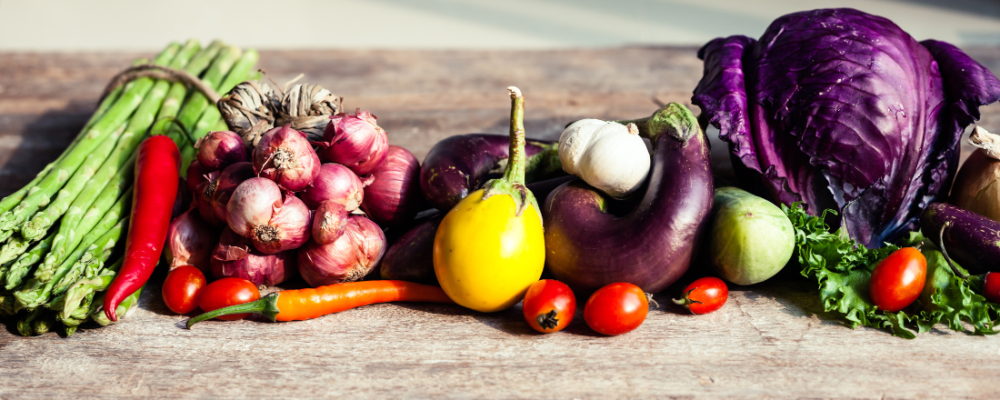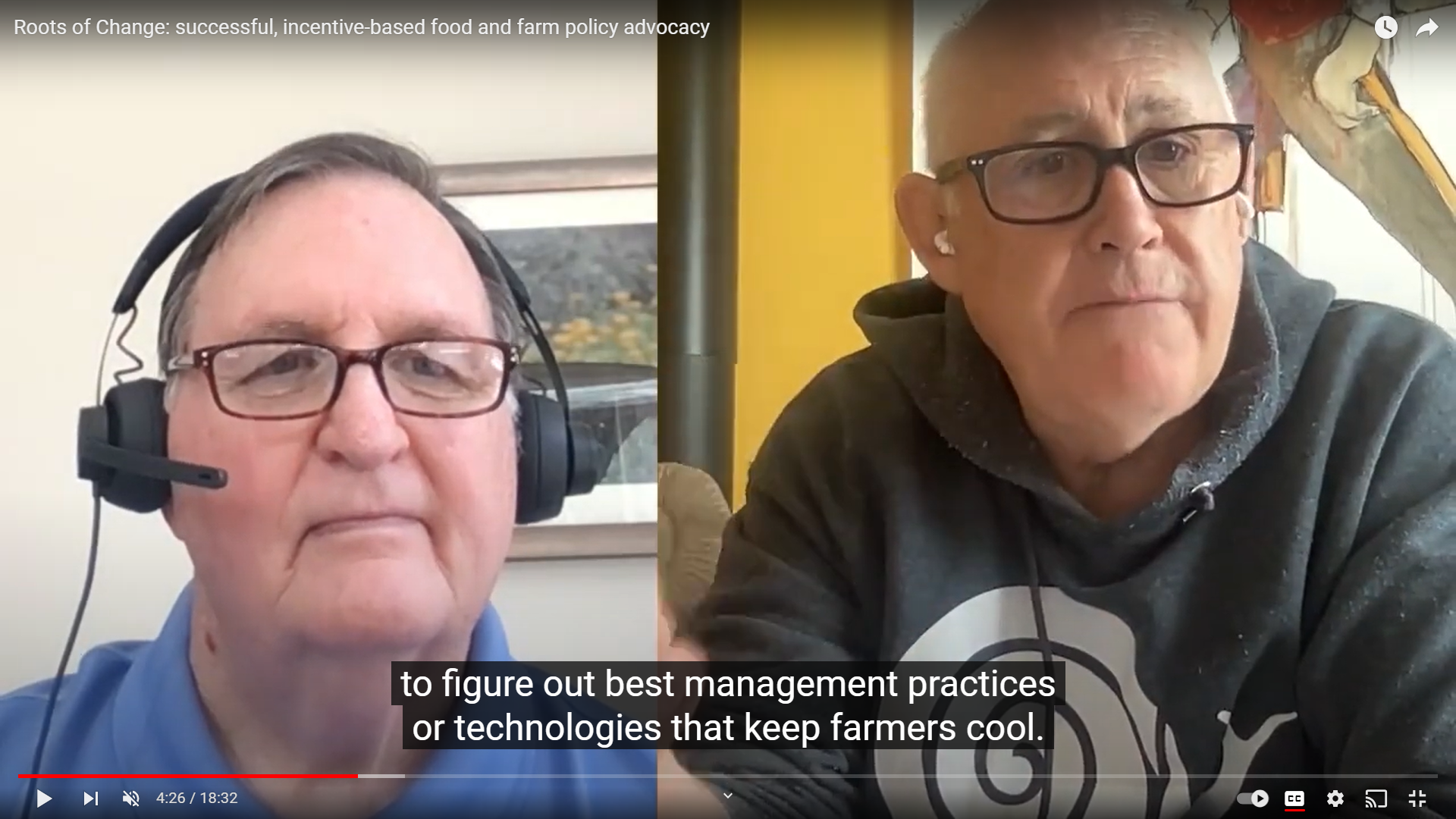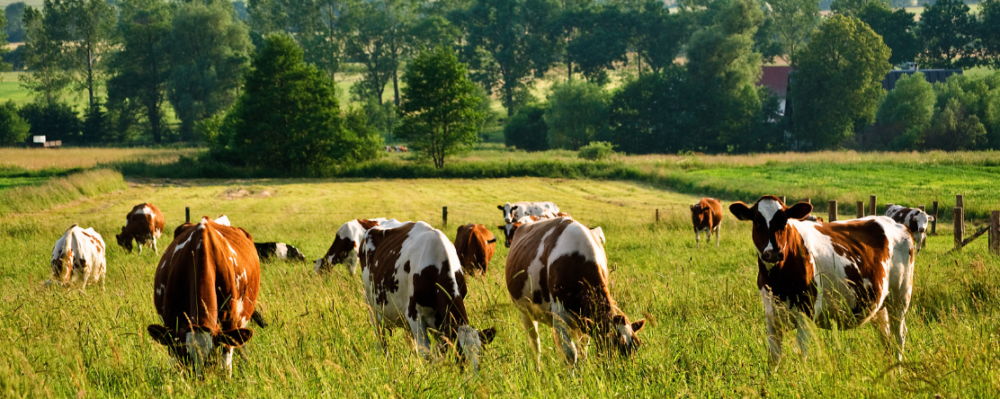
Podcast: PHI’s Michael Dimock Discusses Food and Farm Policy Advocacy
- Michael Dimock, MA
- Kelly Brownell
-
Focus Areas
Chronic Disease Prevention, Healthy Communities -
Issues
Nutrition & Food Security -
Expertise
Public Policy Advocacy -
Programs
Roots of Change

PHI’s Michael Dimock, executive director of our Roots of Change program, joins The Leading Voices in Food podcast for a conversation about transforming food systems through innovative policies. Listen to the podcast to learn about how Roots of Change collaborates with various stakeholders to create nutrition incentive programs and support sustainable agriculture, focusing on community-first approaches.
Topics discussed include pioneering projects, insights into policy influence, and the future of agricultural practices.
Watch:
Interview Summary
Why don’t we begin by you explaining what Roots of Change does. What’s the mission and role of the organization?
Yes. We were originally founded by a group of philanthropic foundations that were very interested in food system change but had not seen much success in years. So we were really designed to be a catalyst to ignite the growth of what we would call the Good Food Movement. For 10 years, we were actually a philanthropic fund investing in different projects that built the power of the food movement. And then implemented projects that would catalyze change. That would show how you could scale change fairly rapidly by building collaboration. So that’s really what we’ve been doing. And in 2013, the philanthropic fund ended, we’d spent down all the money. So we joined the Public Health Institute at that time because public health is such an incredibly important engine for food system change because the food system impacts public health so greatly. We’ve been since that time focused on policy change and implementing model demonstration projects.
Thanks for that explanation. You talked about catalyzing change for transforming the food system. What sort of changes have you emphasized?
We’ve been focused on a few key things. I would say that one of the most important for us has been healthy food access. And doing that through the creation of nutrition incentive programs. And the reason we’re interested in that is, all the changes that we pursue are aimed to hit several different levers of change simultaneously. By building nutrition incentive programs, you help the small and midsize farmers who are supplying local grocery stores, the farmers markets, and at the same time, you’re creating the funding for low-income families to actually purchase organic, regenerative, sustainable agriculture. From their local market. You get a lot of payoff for that kind of action.
You mentioned incentives. How do incentives fit into this?
There is a program, a federal program called the GUSNIP. Named after Gus Schumacher, who was Undersecretary at USDA during the Clinton years, and actually worked with us early on. And so that program is a pool of funding through the Farm Bill that is given as grants to either states or nonprofits that are creating these programs where a family comes in with their SNAP benefits, and their purchasing power is doubled. They’re given matching dollars to buy fruits and vegetables from a farmer’s market, a local store, grocery store. So it’s an incentive to purchase fresh nutritious food. And so, we have worked on the original federal policy. We’re one of the first demonstration projects to show how you do nutrition incentives working with folks in the upper Midwest and in the East. And then we created an analog. California also has a matching fund which helps us pull more money from the federal level. So, we can really get a big impact at the local level. And we built that California program as well. We’ve been really deep in nutrition incentives.
But we also work on farmer farmworker protections from heat. It’s a big problem out here in the West. Increasing temperatures. We’re working with different scientists, epidemiologists, and farmers to figure out best management practices or technologies that keep farmers cool. And then we also work on programs to provide incentives for ranchers to produce regenerative meat, that is grass-finished meat.
So, those are the three areas working in right now. But we’re also just starting a project. I have a meeting today with the California Department of Food and Agriculture to develop a plan for mid and small-scale infrastructure for regional food systems in the state of California to be achieved by 2040.
One thing I really like about your approach is the lining up of incentives to produce food in a way that’s better for both human health and the environment. Because so many incentives are lined up the other way. Obviously, the food industry wants to make as much money as they can, and that comes from highly processed foods that aren’t very good for health. And then the same sort of incentives lines up for agriculture to do industrial forms of agriculture where you maximize the yield per acre. To turn that around is really going to be a major effort. One thing I like about your approach is that you’re trying different things that can become models for what could be used in a very broad scale in terms of public policy. I really admire that and like what you’re doing. Do you have an overall strategy for helping bring about change?
One of the things that we did in 2010-11 is we did a deep analysis of the food system and did a systems dynamic map of the entire food system. Working with leaders, Secretary of Agriculture for California, farmers – big size, small size, organic, conventional, with food justice folks. And we looked at where are the real intervention points. One of the things that we really realize is that, as you were pointing out, the current incentives are for industrialization, basically. And so, the question is, how do you actually change that? And policy is one important lever for doing that. So, we work a lot on trying to change the policy levers to create incentives for what we would call healthy and resilient agriculture.
Tell me more about how you go about doing that. I’d love to hear when you’re done with that, how you go about doing that with policymakers.
Well, I’ll jump right in on that. Let’s look at what we did with nutrition incentives. So, working with Fair Food Network out of the upper Midwest, and Wholesome Wave out East, Roots of Change did a study. We created our own nutrition incentive programs using philanthropic dollars and some USDA kind of innovative dollars, and then we studied it for two years, what the impacts were. We wrote a report then, which went to Congress, to Debbie Stabenow in Minnesota, who was the Senator there who was on the ag committee. And she began writing a bill that would say, okay, let’s provide incentives for people to buy healthy food that also helped the small farmers. So that switched the incentive from the big agricultural systems to the regional food system players. That was one way we did it.
The other thing that we did in California was we organized all the farmers markets to go to the State of California and say, look, if you provide this nutrition incentive program in California and analog, we’ll pull down more dollars from the federal government. The California legislature said that’s a great idea. They got on board. Which then helped the farmers markets to provide more funding because farmers markets are often stressed. Too many markets, so there’s problems. Competition between markets. So, to provide a new market, which is low-income families who are using nutrition incentives and their SNAP dollars, that was really important for the farmer’s market. Those farmer’s markets became another big piece of our strategy. Our way of making change was just to build collaborations, large collaborations of people.
We work with many other nonprofits and farming groups in California to approach the legislature and over the last three years we’ve gotten $1.3 billion dollars in investments from the state of California into sustainable agriculture and food justice. Because we’re able to build these large collaborations who convince the legislators who really care about votes that there’s enough people out there want to see this happen. And we have just placed a billion-dollar request on the next bond, which will be in the next election, November. This November there’s the climate bond. It’s called a climate bond for the State of California. Ten billion dollars, one billion of that will be dedicated to nutrition, nutritional health, farm workers, and sustainable agriculture.
So, in all ways, it’s about getting enough voices. So, if you look at what we’re really trying to do, we’re trying to build the power of what we would call the Good Food Movement.
Best of luck with that billion-dollar request. I really hope that goes through. You know, in the beginning of your response to my last question, you talked about a report that you did in concert with other organizations around the country and how that became influential in the policy process. Very often, some of the people in my orbit, scientists, wonder how they can help with this kind of thing and how they can do work that makes a difference. And I’ve often thought that speaking with people in the policy and advocacy world, like you, turns up some really interesting questions they could help address, if they knew what those questions were. But they often aren’t having those conversations because they’re mainly speaking to other scientists. That’s one of the reasons why I so much like having people who approach things like you do on this podcast series. Scientists aren’t our only listeners, but they’re among them, and it’s nice to give them ideas about how they can connect their work with what’s going on out there on the ground in terms of policymaking. So, you emphasize putting people in communities first. What does that mean? And how does that play out in the work you do?
It’s a great segue from what you were just saying about the need to combine community voices with nonprofits and scientists, academics, and people who are good at research and who are good at analysis. Back to this idea of nutrition incentives that really grew out of what community groups were doing. The IRC (the International Rescue Committee) works with immigrants from Africa, primarily at that time who were coming into San Diego. And they were farmers, mostly. They were escaping violence, war, in their countries. And they came to San Diego and the IRC worked with them to create a farmer’s market, and a farm – a community farm. And those folks were the ones that were saying, this program works. And this is a really good way to solve many problems at once. So, we were hearing from community members and the nonprofit that had created this model. So, it was a way of us understanding what was actually working on the ground. So that’s one example.
I can also say that in 2017, 2019 and 2020, we had terrible fires here in California. We also had all that followed with COVID in 2020. We were working with the University of California at Davis. Tom Tomich, who at that time was with the Ag Sustainability Institute at UC Davis. And we were doing research on how do you deal with climate change as small farmers? And what we realized is there was this moment in time when all of these things that have been piling up were impacting the ability to get meat. You’ll remember that meat disappeared from shelves for a while because all the big plants that process meat in the Midwest were shut down due to COVID. So, what we did is then went out and we interviewed ranchers up and down the State of California, and we asked them, what do you need? And are you interested in finishing animals for grass-fed markets? Are you interested in building local markets? We got a lot of feedback that led to a white paper that Roots of Change published with the University of California at Davis and put out to the world. Which led to us getting a grant to actually take some of the suggestions and the recommendations we had gotten from the producers about what to do. What’s that led to now? We have built a relationship with the University of California: ten campuses, five medical systems. They have committed to buy regenerative regional meat from the State of California. That grew out of a white paper, which was fed information by the ranchers on the ground, analyzed by academics and nonprofits, and delivered in a system that’s now gotten the university to make a commitment. So, it’s another example of just how you can mix all these great parties to get some sustainable change at a large scale?
Now that leads me pretty nicely to what my next question. And it has to do with what’s needed going forward and how do these things occur in more places in a bigger way than the places they are now. Now you mentioned, for example, the regenerative agriculture pledge that got made by the University of California system. That’s a big enterprise. There are a lot of people that get touched by that system. So, that’s a pretty impressive example of taking an idea that might’ve been smaller to begin with and then became bigger. Going forward, what kind of things are going to be needed to make that kind of thing happen more often?
That’s a really good question. Kelly, I think that one of it is communication. I mean, perhaps some somebody will hear this and reach out to us and say, how’d you do that? And then we’ll say, well…and they’ll tell us what they did and we’ll learn from them. One of the things I’m really interested in, always been interested in, and one of the things that Roots of Change is focused on is trying to convene people to share information. Because you build partnerships when you share information. And those partnerships can become the engines for getting the policy makers or the corporations to change their modalities. How they’re doing things. Because they realize, hey, the writing is on the wall. This has to happen. We need to figure out how to get there. And sometimes it’s complex to get there because the food system is very complex.
So, I would say that one of the things I’m really looking forward to is more cross collaboration. You know, we’re living in the season of elections. We’re hearing it on the news all the time. And the thing that drives the policy makers is whether or not they’re going to be elected or reelected. And so, the more that we can convince them that there is a large majority of the public that wants to see these fundamental changes in the food system. We will have their support. We’ve seen it in California. We are getting incredible support from our Secretary of Agriculture, our governor, and our Secretary of Natural Resources. They work together to create things on the ground. I would say that the Tom Vilsack and Biden did a lot for regenerative agriculture, working on two big projects that have been funded by the USDA that will touch a thousand ranchers of bison and beef to get them to learn about, adapt, adopt, and then build new markets for their products. So that’s an important piece. The other is the marketplace and companies want to sell their products. So, the more that consumers become discerning and what they’re purchasing, the better off we’re going to be. So, we have a podcast like you do. And what we’re trying to do is just educate people about the connections between what they’re doing and what the farmers and ranchers out there who are trying to do good work with the land and with health and with their workers. We just try to promote this idea of making good decisions about what they purchase.
Tell us a little bit more about your podcast, which is called Flipping the Table. Tell us more about what you’re trying to accomplish and the kind of people that you speak with.
Well, it’s similar to yours in a certain way, I would say. Because what I’m doing is interviewing the people that are doing the kinds of projects that we think are scaling change or could scale change. Or people who have a depth of understanding. So, the regenerative meat world, we’ve done a lot in the last few years. Talking to Nicolette Hahn Nyman, who wrote a couple of books about the meat system, with a great rancher up in Northern California, who advises other ranchers on how to finish their animals on grass in California in a dry environment. I just, today we dropped a podcast with Cole Mannix from the Old Salt Co op in Montana about the ranchers he’s pulled together. The co op he’s built that has a slaughter plant, restaurants, a meat shop, and has an online thing. And then they do a big, they do a big annual event in the summer during the solstice. So, you know, we’re just trying to get voices who, like you are, who are, who are modeling and educating the public around what is happening. How much is actually happening. I’ve been in this world for 30 years almost, and I have to say, I have never been more optimistic about the scale of change, the accelerating speed of change, and the possibilities that lay ahead.
Originally published by The Leading Voices in Food
Work With Us
You change the world. We do the rest. Explore fiscal sponsorship at PHI.
Support Us
Together, we can accelerate our response to public health’s most critical issues.
Find Employment
Begin your career at the Public Health Institute.



